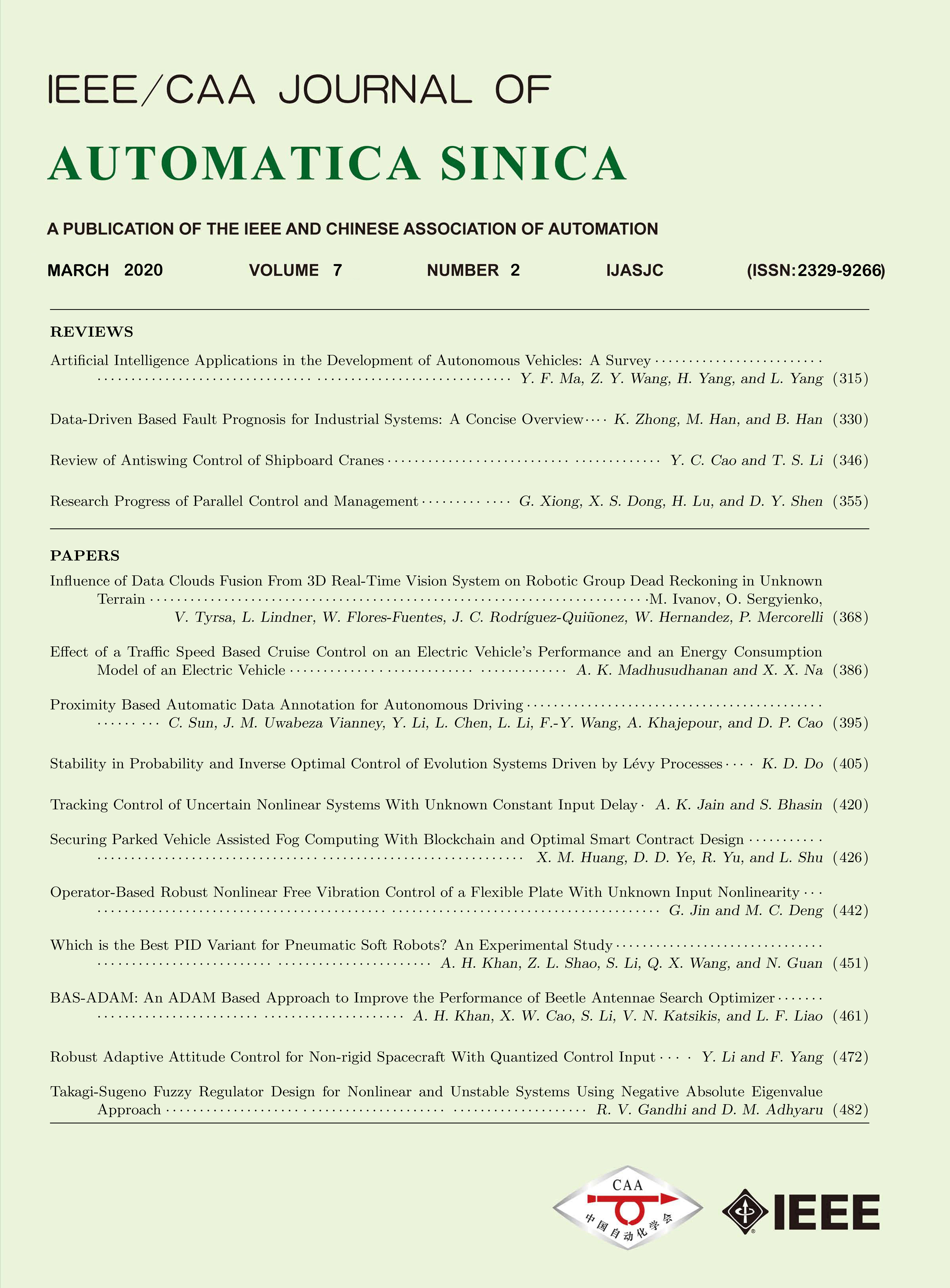 Volume 7
Issue 2
Volume 7
Issue 2
IEEE/CAA Journal of Automatica Sinica
| Citation: | Yun Li and Fan Yang, "Robust Adaptive Attitude Control for Non-rigid Spacecraft With Quantized Control Input," IEEE/CAA J. Autom. Sinica, vol. 7, no. 2, pp. 472-481, Mar. 2020. doi: 10.1109/JAS.2020.1003000 |

| [1] |
O. Brown, P. Eremenko, and C. Roberts, “Cost-benefit analysis of a notional fractionated SATCOM architecture,” in Proc. 24th AIAA Int. Communication Satellite Systems Conf., CA, USA, AIAA 2006–5328, 2006.
|
| [2] |
O. Brown and P. Eremenko, “The value proposition for fractionated space architectures,” in Proc. AIAA Space Forum, CA, USA, AIAA 2006–7506, 2006.
|
| [3] |
D. Fronterhouse, J. Lyke, and S. Achramowicz, “Plug-and-play satellite (PnPSat),” in Proc. AIAA Infotech Aerospace Conf. and Exhibit, CA, USA, AIAA 2007–2914, 2007.
|
| [4] |
J. Lyke, “Plug-and-play satellites,” IEEE Spectrum, vol. 49, no. 8, pp. 36–42, 2012. doi: 10.1109/MSPEC.2012.6247560
|
| [5] |
H. Ishii and B. Francis, Limited Data Rate in Control Systems With Networks. Springer Berlin Heidelberg, 2002.
|
| [6] |
S. Tatikonda and S. Mitter, “Control under communication constraints,” IEEE Trans. Automatic Control, vol. 49, no. 7, pp. 1056–1068, 2004. doi: 10.1109/TAC.2004.831187
|
| [7] |
J. Zhou, C. Y. Wen, and G. H. Yang, “Adaptive backstepping stabilization of nonlinear uncertain systems with quantized input signal,” IEEE Trans. Autom. Control, vol. 59, no. 2, pp. 460–464, 2014. doi: 10.1109/TAC.2013.2270870
|
| [8] |
R. Sharma and A. Tewari, “Optimal nonlinear tracking of spacecraft attitude maneuvers,” IEEE Trans. Control Systems Technology, vol. 12, no. 5, pp. 677–682, 2013.
|
| [9] |
B. L. Wu, D. W. Wang, and E. K. Poh, “High precision satellite attitude tracking control via iterative learning control,” J. Guidance Control &Dynamics, vol. 38, no. 3, pp. 528–534, 2015.
|
| [10] |
H. P. Li, W. S. Yan, and Y. Shi, “Continuous-time model predictive control of under-actuated spacecraft with bounded control torques,” Automatica, vol. 75, pp. 144–153, 2017. doi: 10.1016/j.automatica.2016.09.024
|
| [11] |
S. N. Wu and S. H. Wen, “Robust H∞ output feedback control for attitude stabilization of a flexible spacecraft,” Nonlinear Dynamics, vol. 84, pp. 405–412, 2016. doi: 10.1007/s11071-016-2624-5
|
| [12] |
S. C. Liu, Z. Y. Geng, and J. Y. Sun, “Finite-time attitude control: a finite-time passivity approach,” IEEE/CAA J Autom. Sinica, vol. 2, no. 1, pp. 102–108, 2015. doi: 10.1109/JAS.2015.7032911
|
| [13] |
W. C. Cai, X. H. Liao, and Y. D. Song, “Indirect robust adaptive fault -tolerant control for attitude tracking of spacecraft,” J. Guidance Control &Dynamics, vol. 31, no. 5, pp. 1456–1463, 2008.
|
| [14] |
W. C. Luo, Y. C. Chu, and K. V. Ling, “Inverse optimal adaptive control for attitude tracking of spacecraft,” IEEE Trans. Autom. Control, vol. 50, no. 11, pp. 1639–1654, 2005. doi: 10.1109/TAC.2005.858694
|
| [15] |
D. Seo and M. Akella, “High-performance spacecraft adaptive attitudetracking control through attracting-manifold design,” J. Guidance Control &Dynamics, vol. 31, no. 4, pp. 884–891, 2008.
|
| [16] |
Q. L. Hu, X. D. Shao, and L. Guo, “Adaptive fault-tolerant attitude tracking control of spacecraft with prescribed performance,” IEEE/ASME Trans. Mechatronics, vol. 23, no. 1, pp. 331–341, 2018. doi: 10.1109/TMECH.2017.2775626
|
| [17] |
D. Thakur, S. Srikant, and M. Akella, “Adaptive attitude-tracking control of spacecraft with uncertain time-varying inertia parameters,” J. Guidance Control &Dynamics, vol. 38, no. 1, pp. 41–52, 2015.
|
| [18] |
Q. L. Hu, Y. X. Shi, and X. D. Shao, “Adaptive fault-tolerant attitude control for satellite reorientation under input saturation,” Aerospace Science &Technology, vol. 78, pp. 171–182, 2018.
|
| [19] |
Y. Li, C. L. Wang, and W. Wang. Adaptive quantized attitude control for spacecraft with input saturation. in Proc. IEEE Int. Conf. Control & Automation, Ohrid, Macedonia, 449–454, 2017.
|
| [20] |
B. L. Wu, “Spacecraft attutude control with input quantization,” J. Guidance Control &Dynamics, vol. 39, no. 1, pp. 176–181, 2015.
|
| [21] |
X. Y. Lang, J. Damaren, and X. B. Cao, “Passivity-based attitude control with input quantization,” Institution of Mechanical Engineering Part G: J. Aerospace Engineering, 2018.
|
| [22] |
H. B. Sun, L. L. Hou, G. D. Zong, and X. H. Yu, “Fixed-time attitude tracking control for spacecraft with input quantization,” IEEE Trans. Aerospace &Electronic Systems, vol. 55, no. 1, pp. 124–134, 2019.
|
| [23] |
B. L. Wu and X. B. Cao, “Robust attitude tracking control for spacecraft with quantized torques,” IEEE Trans. Aerospace &Electronic Systems, vol. 54, no. 2, pp. 1020–1028, 2018.
|
| [24] |
C. L. Wang and Y. Lin, “Decentralized adaptive tracking control for a class of interconnected nonlinear time-varying systems,” Automatica, vol. 54, pp. 16–24, 2015. doi: 10.1016/j.automatica.2015.01.041
|